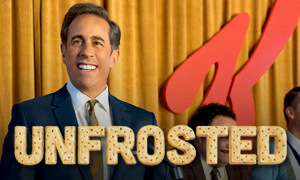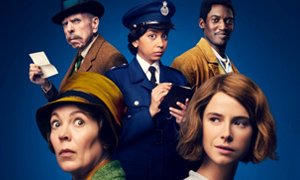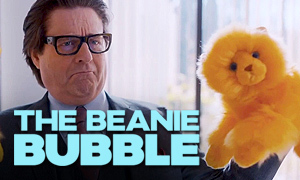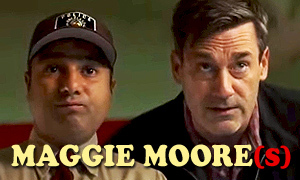Saving Mr. Banks: History vs. Hollywood
based on Walt Disney's struggle to get the screen rights to 'Mary Poppins' from author P.L. Travers
| REEL FACE: | REAL FACE: |
Tom Hanks
Born: July 9, 1956 Birthplace: Concord, California, USA | Walt Disney
Born: December 5, 1901 Birthplace: Chicago, Illinois, USA Death: December 15, 1966, Los Angeles, California, USA (lung cancer) |
Emma Thompson
Born: April 15, 1959 Birthplace: Paddington, London, England, UK | Pamela Lyndon Travers
Born: August 9, 1899 Birthplace: Maryborough, Queensland, Australia Death: April 23, 1996, London, England, UK (deteriorating health from old age) |
Jason Schwartzman
Born: June 26, 1980 Birthplace: Los Angeles, California, USA | Richard Sherman
Born: June 12, 1928 Birthplace: New York City, New York, USA |
B.J. Novak
Born: July 31, 1979 Birthplace: Newton, Massachusetts, USA | Robert Sherman
Born: December 19, 1925 Birthplace: Brooklyn, New York, USA Death: March 6, 2012, London, England, United Kingdom |
Colin Farrell
Born: May 31, 1976 Birthplace: Castleknock, Dublin, Ireland | Travers Goff
|
Ruth Wilson
Born: January 13, 1982 Birthplace: Ashford, Kent, England, UK | Margaret Goff
|
Rachel Griffiths
Born: December 18, 1968 Birthplace: Melbourne, Victoria, Australia | Helen Morehead (aka Aunt Ellie)
(part of the inspiration for the Mary Poppins character) |
Bradley Whitford
Born: October 10, 1959 Birthplace: Madison, Wisconsin, USA | Don DaGradi
Born: 1911 Birthplace: New York City, New York, USA Death: August 4, 1991, Harbor, Washington, USA |
Who is "Mr. Banks" from the movie's title?
Mr. Banks is the patriarch of the London family that Mary Poppins helps in the book and movie. Author P.L. Travers based the Mr. Banks character in part on her own father, Travers Goff, portrayed by Colin Farrell in the film Saving Mr. Banks.
Did Walt Disney really promise his children he'd turn P.L. Travers book Mary Poppins into a movie?
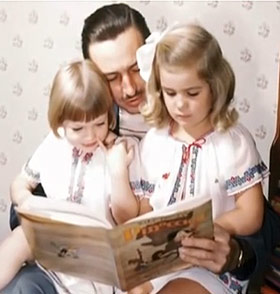
Walt had assured his daughters (pictured above) that their beloved Mary Poppins would unleash her magic on the big screen.
How long did it take Walt Disney and his team to convince author P.L. Travers to let them turn her book into a movie?
After nearly twenty years of courting P.L. Travers via letters and phone calls, she finally gave in to Walt Disney's pleas. Upon her arrival in California, it took two weeks for Walt Disney and his team to convince author Pamela Lyndon Travers to allow them to turn her beloved book Mary Poppins into a movie. Similar to what is seen in Saving Mr. Banks, her 1961 visit proved grueling for Disney and his team. "I find myself getting angry when I relive it," says songwriter Richard Sherman, actor Jason Schwartzman's real life counterpart, "My stomach tightens when I talk about it." -SFGate.com
Did Ralph the limo driver (portrayed by Paul Giamatti) actually exist?
Producer Ian Collie revealed that Ralph (Paul Giamatti) is an amalgamation of several of P.L.'s drivers. Actor Paul Giamatti says that the character was included in the film because the screenwriter and the producers wanted someone who P.L. Travers (Emma Thompson) could warm up to. -Glamour.com
What made author P.L. Travers change her mind about letting Walt turn her book into a movie?
As explained in the Saving Mr. Banks movie, the royalties from her book were dwindling and her lawyer encouraged her to allow Disney to adapt the book for the screen. She agreed and was given a $100,000 advance, in addition to being guaranteed five percent of the film's royalties, which resulted in her becoming a multi-millionaire. She was also given the chance to personally approve the script. -DailyMail.co.uk
The real P.L. Travers had never been a fan of Walt Disney. In her review of Disney's first full-length animated feature film, 1937's Snow White and the Seven Dwarfs, she wrote, "Oh, he's clever, this Disney! ... The very pith of his secret is the enlargement of the animal world and a corresponding deflation of all human values. There is a profound cynicism at the root of his, as of all, sentimentality." -The Secret Life of Mary Poppins
Did the real P.L. Travers not want animation in the movie version of her book?
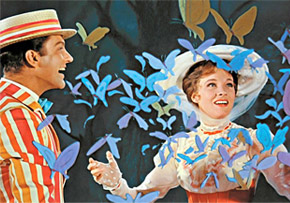
Dick Van Dyke and Julie Andrews in one of several Mary Poppins scenes that incorporated animation.
If Travers had script approval, how did the animation end up in the Mary Poppins film?
Whether it was trickery by Walt Disney or simply a lack of knowledge on Travers's part, the terms of their agreement gave Pamela Lyndon Travers script approval but not film editing rights. Travers had approved the script figuring that she could decide what stayed in the film. "When do we start cutting it?" Travers asked Walt after screening the movie. Disney explained to her that she only had script approval but not film editing rights. Knowing that his version would surely win over audiences, he refused to make the changes Travers wanted. This infuriated the author. -MentalFloss.com
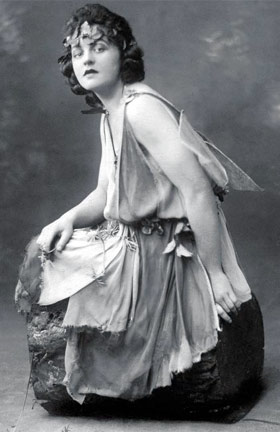
Once an aspiring actress, Travers is pictured as Titania in A Midsummer Night's Dream (1920s).What is P.L. Travers full name?

Once an aspiring actress, Travers is pictured as Titania in A Midsummer Night's Dream (1920s).
The Saving Mr. Banks true story reveals that Pamela Lyndon Travers (P. L. Travers) was born Helen Lyndon Goff (known to her family as Lyndon) in Maryborough, Queensland, Australia on August 9, 1899. At the age of seventeen, she was performing on stage in Australia and New Zealand with a Shakespearean touring company. It was around that time that she adopted the stage name Pamela Lyndon Travers. The last name Travers was the first name of her father, Travers Goff, a bank employee who died of influenza when she was a child. The name Pamela was popular at the time and was her own invention.
Using her first and middle initials as a writer was not uncommon at the time in Britain, especially for women who wanted their work to be appreciated from a gender-neutral standpoint. Harry Potter author J.K. Rowling (Joanne Kathleen Rowling), an admirer of Travers, carried on her tradition by doing the same thing. However, it should be noted that Rowling was not given a middle name at birth. The 'K' comes from her grandmother's name 'Kathleen' and was suggested by the publisher out of fear that potential readers would be less receptive to a wizarding story penned by a woman.
Was P.L. Travers's father really an alcoholic bank employee?
Yes. P.L. Travers's father, Travers Robert Goff (portrayed by Colin Farrell in the movie), was a heavy drinker. As noted by biographer Valerie Lawson in her book Mary Poppins, She Wrote (available in the right column), Travers Goff was a bank manager before being demoted to a bank clerk, dying of influenza in his early forties and leaving his family destitute. P.L. Travers was only seven at the time of her father's death. -Telegraph
What happened to P.L. Travers family after her father died?
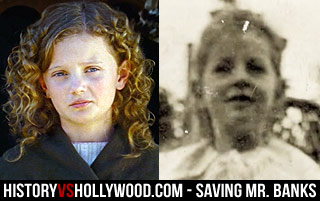
A young P.L. Travers (Annie Buckley) in the Saving Mr. Banks movie (left) and in real life (right) circa 1906.
Did P.L. Travers's mother really contemplate suicide after Travers's father's death?
Yes. Following the death of P.L. Travers's father from influenza when she was seven, her mother, stricken with grief, informed her that she was going to drown herself in a nearby lake, telling her daughter to look after her two younger sisters, Moya and Biddy. Margaret Goff's suicide attempt was unsuccessful and she returned home, but the event left a permanent scar on young P.L. (then known as Lyndon).
Was Mary Poppins really based on P.L. Travers's great aunt?
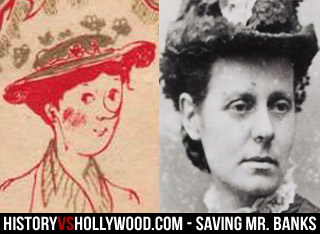
Mary Poppins (left), as seen on the book's original cover, was partially inspired by Travers's Great Aunt Ellie.
Did P.L. Travers base Mr. and Mrs. Banks from the Mary Poppins story on her own parents?
Pamela Lyndon Travers always claimed that her difficult upbringing had little influence on the story. "I don't know that it's based on my personal life," said Travers in 1977. "I think Mr. Banks is a little bit like my father, and Mrs. Banks in her most flustered is perhaps a little bit like my mother; but really, I don't think it's based on my childhood." -The Secret Life of Mary Poppins
Travers was well-known for being extremely secretive about both her life and her inspirations for her book Mary Poppins, often re-imagining her past as something that it never was. Travers once wrote, "If you are looking for autobiographical facts. Mary Poppins is the story of my life." As more was learned about her past, it became clear that her statement was far from the truth. -Telegraph.co.uk
Was P.L. Travers really as difficult as the movie implies?
Yes. As author Valerie Lawson indicates in her book Mary Poppins, She Wrote, the real P.L. Travers fruitlessly tried to protect her creation from being corrupted by the influences of Walt Disney and pop culture. Lawson explains that the Mary Poppins character in Travers's books "was tart and sharp, rude, plain and vain." She demonstrates characteristics that are more similar to P.L. Travers than to Julie Andrews.
During our investigation into the Saving Mr. Banks true story, we discovered that some of the things that Travers objected to with regard to the Mary Poppins movie included the animated horse and pig; the song "Let's Go Fly a Kite"; the notion that Mary Poppins would have a romance with a mere chimneysweep; turning Mrs. Banks into a suffragette; naming Mrs. Banks Cynthia instead of Winifred (Travers won that battle); the grandness of the Banks house; certain American words and phrases; and the casting of Dick Van Dyke and Julie Andrews (she felt Andrews was too pretty compared to the plain, short and thin lady in the book). -MentalFloss.com
Was "Let's Go Fly a Kite" the song that won over Poppins author P.L. Travers?
No. In the Saving Mr. Banks movie, P.L. Travers (Emma Thompson) begins tapping her toes when she first hears "Let's Go Fly a Kite." However, according to Poppins songwriter Richard M. Sherman (portrayed by Jason Schwartzman in the film), "Feed the Birds" was actually the song that broke her. -SFGate.com
Did actor Jason Schwartzman really perform the songs in the movie?
Yes. Actor Jason Schwartzman, who portrays songwriter Richard Sherman in the Saving Mr. Banks movie, is really singing songs like "Feed the Birds" in the film and he is actually the one playing the piano too. "Jason and I did a lot of talking," the real Richard Sherman says. "He listened and watched me play. He's a musician himself, a drummer, but he plays the piano a little - more in a jazz style." -SFGate.com
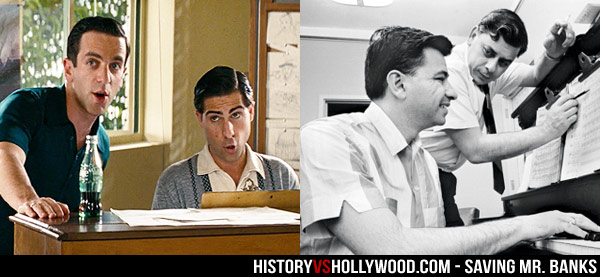
Robert (B.J. Novack) and Richard Sherman (Jason Schwartzman) composing in the movie (left). The real Sherman Brothers, Robert (standing) and Richard (sitting), working on a song together at Disney (right).
Why does Robert Sherman (B.J. Novak) walk with a limp in the movie?
In the movie, Pamela Travers (Emma Thompson) makes a snide remark after learning that Robert Sherman (B.J. Novak) had been shot in the leg. "It's hardly surprising," she says. According to the real Robert Sherman's obituary, his limp was the result of being shot in the knee while charging a hill during World War II, for which he was awarded a Purple Heart. At only nineteen years of age, he had also taken part in the liberation of the Dachau concentration camp.
Did Travers really dislike the songs used in the film?
Yes. "She hated everything," says songwriter Richard Sherman. Like in the movie, the real P.L. Travers insisted that they not make up words, including having the chimney sweep Bert (portrayed by Dick Van Dyke in the 1964 Mary Poppins film) rhyming "responstable" with "constable." -Variety.com
What other Disney songs were the Sherman Brothers responsible for?
In addition to all of the Mary Poppins songs, including "A Spoonful of Sugar," "Supercalifragilisticexpialidocious" and the Oscar-winning "Chim Chim Cher-ee," songwriting brothers Robert and Richard Sherman also wrote "Trust in Me" from The Jungle Book; "The Age of Not Believing" from Bedknobs & Broomsticks; "Winnie the Pooh"; and the most well-known of them all, "It's a Small World," the Disneyland theme song. "I've been in India, I've been in Brussels, all over the world, people know that song," says the real Richard Sherman. "I think (people) want to either kiss us or kill us for having written "It's a Small World." -Variety.com
Was P.L. Travers really not invited to the Mary Poppins premiere?
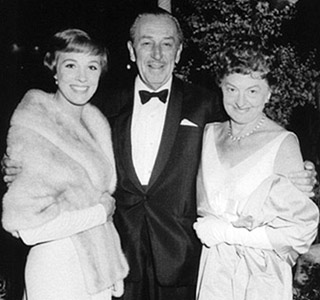
P.L. Travers (right) with Walt Disney and Julie Andrews, who Travers believed was too pretty to be Mary Poppins.
Did Travers continue insisting that the animated sequences be cut, even at the film's premiere?
Yes. After seeing the film on the night of the premiere, a distraught Travers went up to Walt Disney and demanded that the animation be cut from the film. "Pamela, that ship has sailed," Disney replied before walking away. Pamela Travers's feud with Walt Disney would continue up to and beyond her death, prohibiting Disney from adapting any more of her books and vigorously protecting the stage rights to Mary Poppins (she would eventually turn the rights over to British theater producer Cameron Mackintosh in 1993).
Did the real P.L. Travers weep at the Mary Poppins movie premiere?
Yes. Travers's disapproval and anger over the inclusion of partially animated scenes in the film caused her to weep by the end of the 1964 Hollywood movie premiere of Mary Poppins (Telegraph.co.uk). In a letter to her lawyer, Travers described her horror over what she had seen at the premiere, "As chalk is to cheese, so is the film to the book. Tears ran down my cheeks because it was all so distorted. I was so shocked I felt that I would never write---let alone smile---again!" (The Secret Life of Mary Poppins)
In a rare 1977 interview, P.L. Travers commented on the legacy of the film, "I've seen it once or twice, and I've learned to live with it. It's glamorous and it's a good film on its own level, but I don't think it is very like my books." -The Secret Life of Mary Poppins
I heard that P.L. Travers ruined the lives of two boys. Is that true?
Though it was not shown in the film, author P.L. Travers did not weave similar magical tales when it came to her personal life. In 1940, she became aware of a destitute family that she knew in Ireland who were looking for someone to adopt their infant identical twins. The children had been born to an irresponsible father and an inept mother, and were in the care of their grandparents who were having trouble coping with the responsibility of raising four children. They arranged for a family friend from London, Pamela Lyndon Travers, to adopt both of the infant twins, at least that was their understanding. Travers was approaching her 40th birthday and had given up hope on finding a lasting relationship that might produce biological children. She was attracted to the literary lineage of the twins.
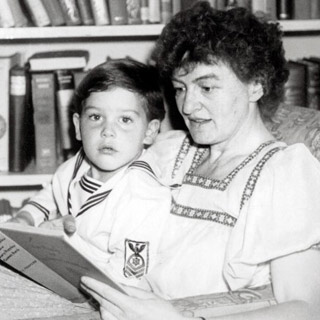
Trying to choose between two identical twins, P.L. Travers selected her adopted son Camillus based on advice from her astrologer. She refused to take them both.
The twins reunited at age seventeen when Tony showed up unannounced on P.L. Travers's doorstep to meet his brother Camillus. Travers had previously told Camillus that he was her own and that his father had died of an accident in the colonies where he was a wealthy sugar magnate. The two brothers had little in common other than a fondness for alcohol and would only see each other occasionally in the years that followed. Camillus eventually developed a drinking problem and spent six months in prison after being arrested for driving drunk without a license. His twin brother Anthony would also develop an alcohol problem, which would cost him his family and his career in public relations. Prior to Anthony's death, his ex-wife Frances would tend to his basic needs as she listened to him "moaning" about his brother's good fortune. -DailyMail.co.uk
Ironically, Camillus's widow, also named Frances, says that he had been left "disappointed and sad" after being made aware that he had been plucked from his natural family. "He would have liked to belong to them because they were artistic and interesting, and as he grew up he didn't have any brothers, sisters or aunts and uncles, or a Daddy — only her." -DailyMail.co.uk
Did P.L. Travers stipulate in her will that Mary Poppins not be touched by Disney again?
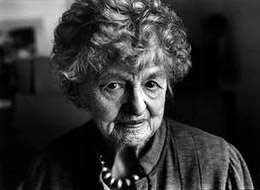
P.L. Travers, who lived to be 96, is pictured in the years prior to her death in 1996.
I heard that Travers's publisher was the son of Peter Pan author J.M. Barrie?
This is true. P.L. Travers's connection to Peter Pan author J.M. Barrie wasn't only reflected in the similarities between Mary Poppins and Barrie's high-flying Pan. Travers's publisher was Peter Davies, the adopted son of J.M. Barrie and the inspiration for Peter Pan (Davies later committed suicide partially as the result of his lifelong association with the Pan character).
P.L. Travers Audio & the Saving Mr. Banks Movie Trailer
After learning about the Saving Mr. Banks true story above, enjoy the related videos below, including the movie trailer and excerpts from P.L. Travers's Disney meetings.
WATCH P.L. Travers Audio from the Mary Poppins Meetings at DisneyP.L. Travers reads through the Mary
Poppins script with screenwriter Don
DaGradi and brothers Robert and Richard
Sherman, the duo behind the film's music.
The infamous meetings took place at the
Disney Studios in L.A. in 1961. Travers
seems somewhat cordial during these
particular excerpts from her recordings,
but her rigidness can still be detected in
the tone of her voice. |
WATCH P.L. Travers Recorded Discussing "Feed the Birds"This P.L. Travers recording features the
author discussing the Mary
Poppins song "Feed the Birds" with
Richard and Robert Sherman in 1961. During
the discussion, Richard Sherman plays the
song and Travers sings along. Unlike the
Saving Mr. Banks movie, the true
story reveals that "Feed the Birds" was
actually the song that won her over. |
WATCH Saving Mr. Banks TrailerWatch the Saving Mr. Banks movie
trailer for the film that tells the story
of Walt Disney's struggle to please author
P.L. Travers as his company works to adapt
her novel Mary Poppins for the
big screen. Tom Hanks portrays Walt Disney
while actress Emma Thompson fills the role
of P.L. Travers. |
Link-to-Learn More:


